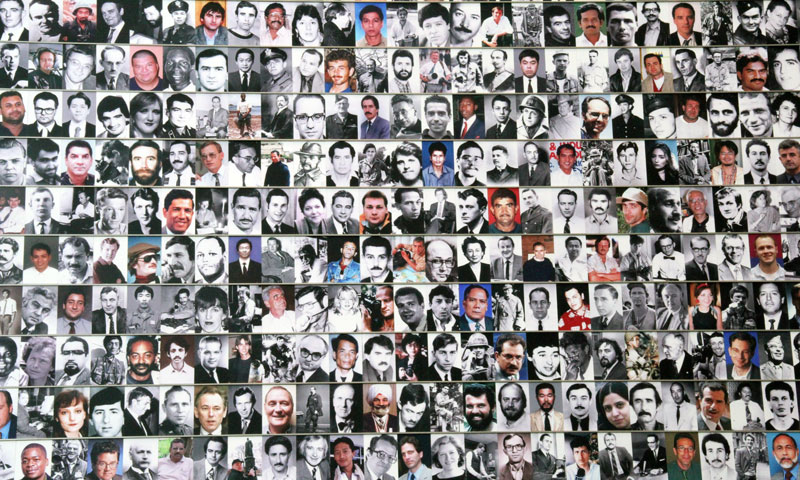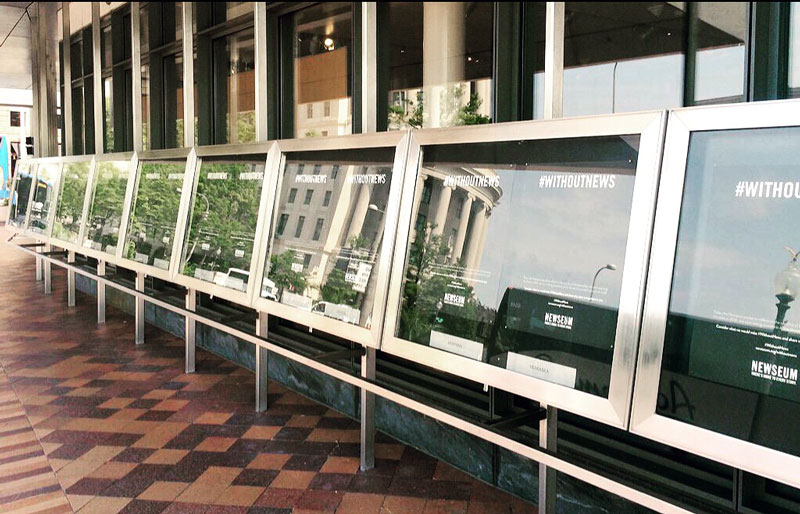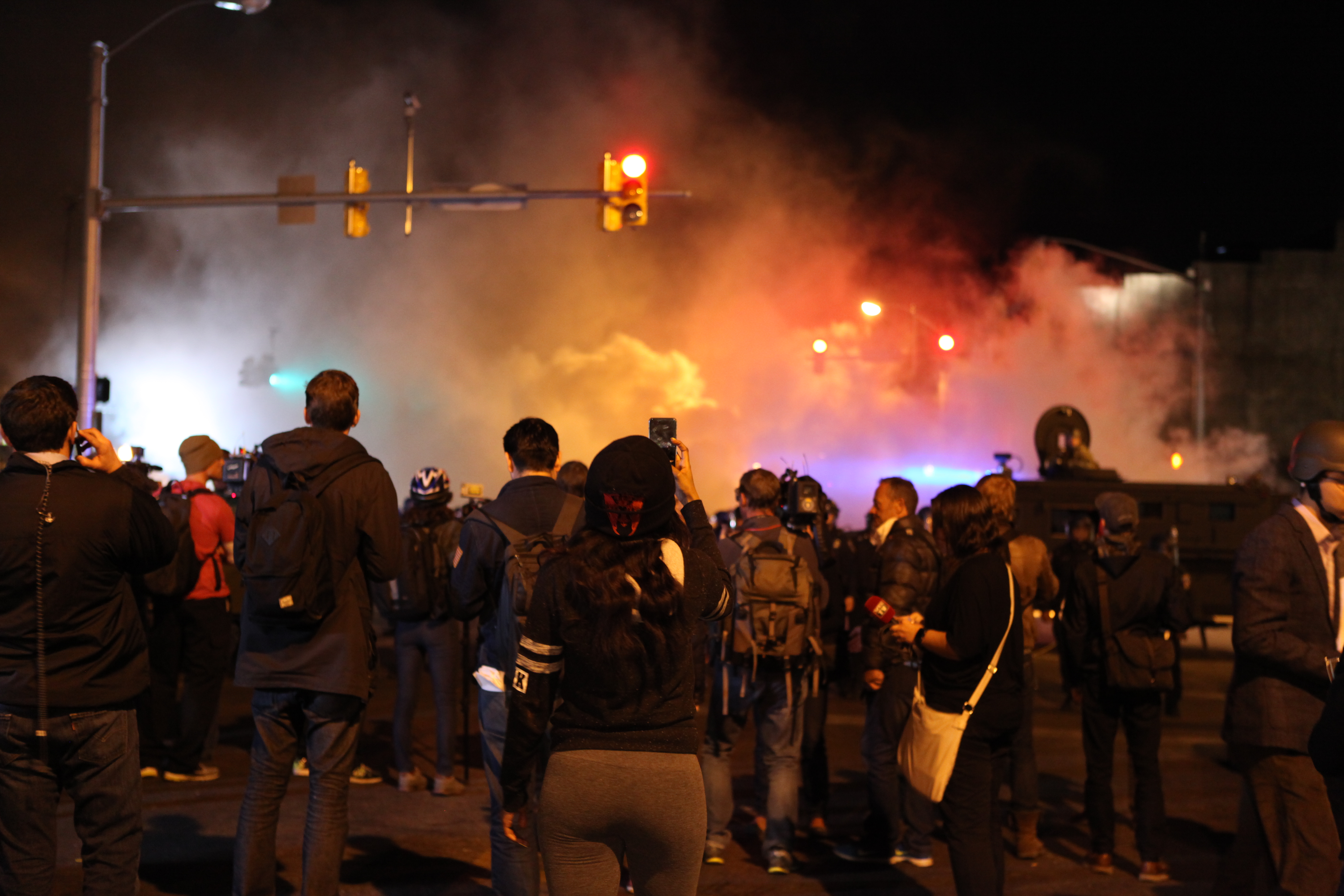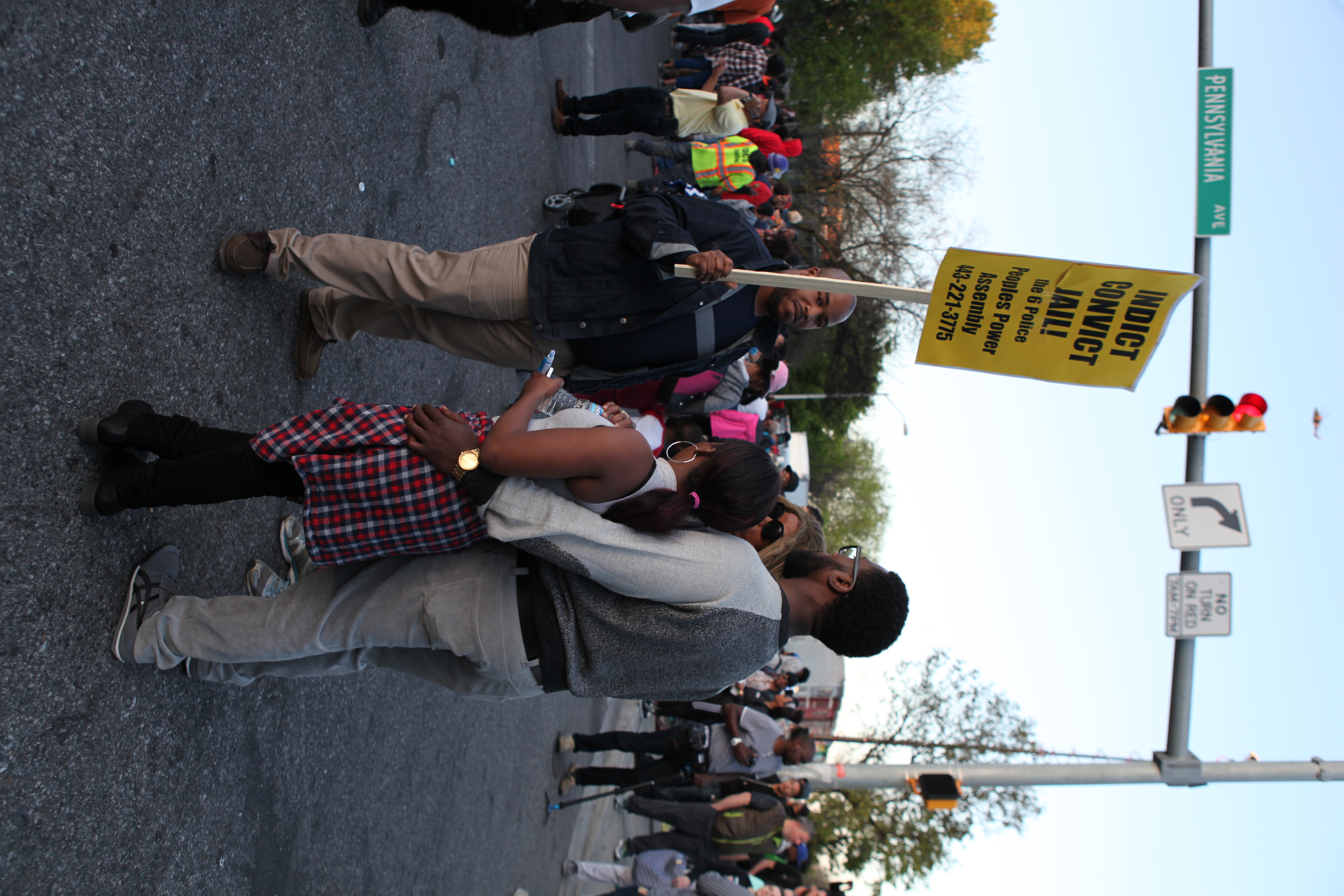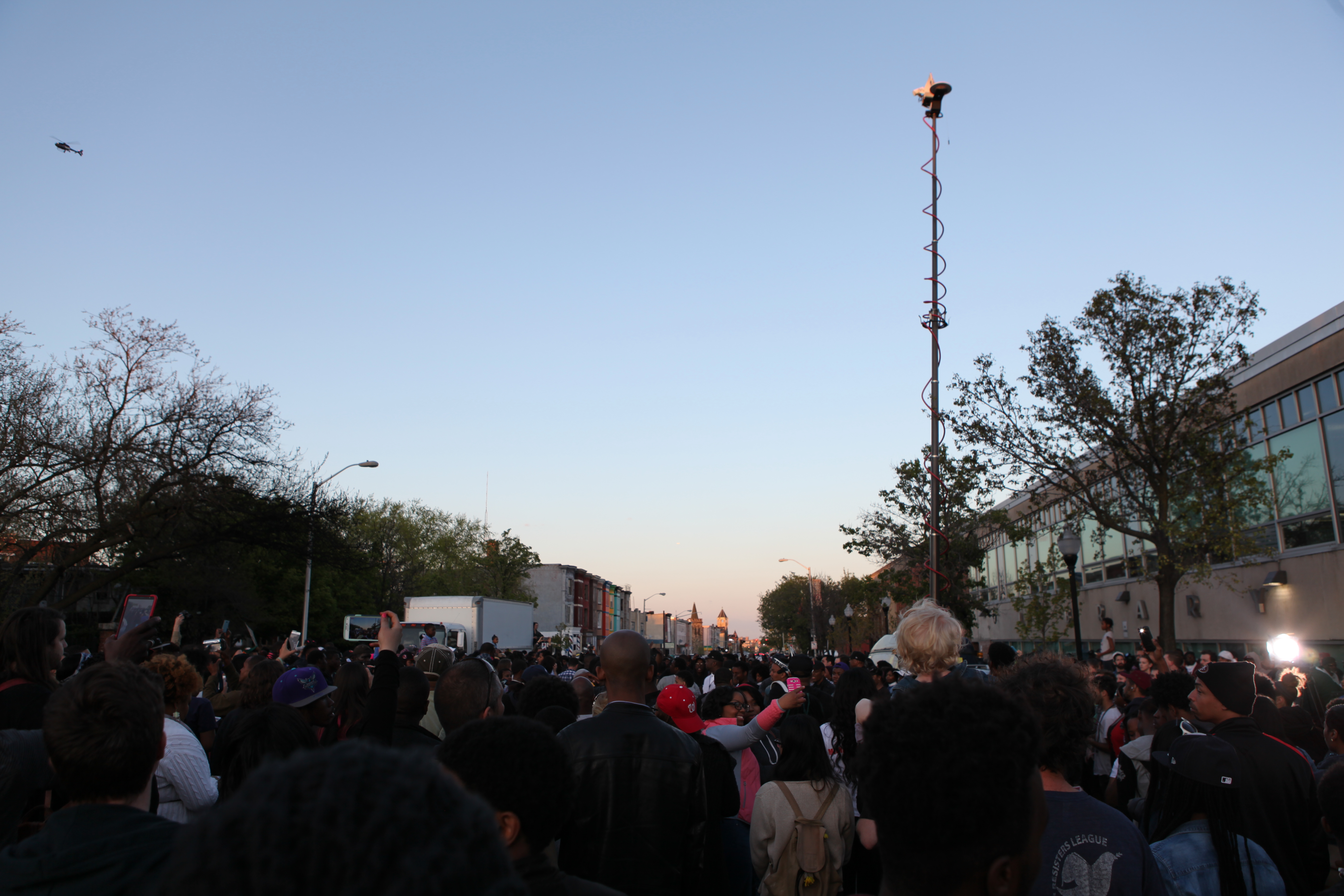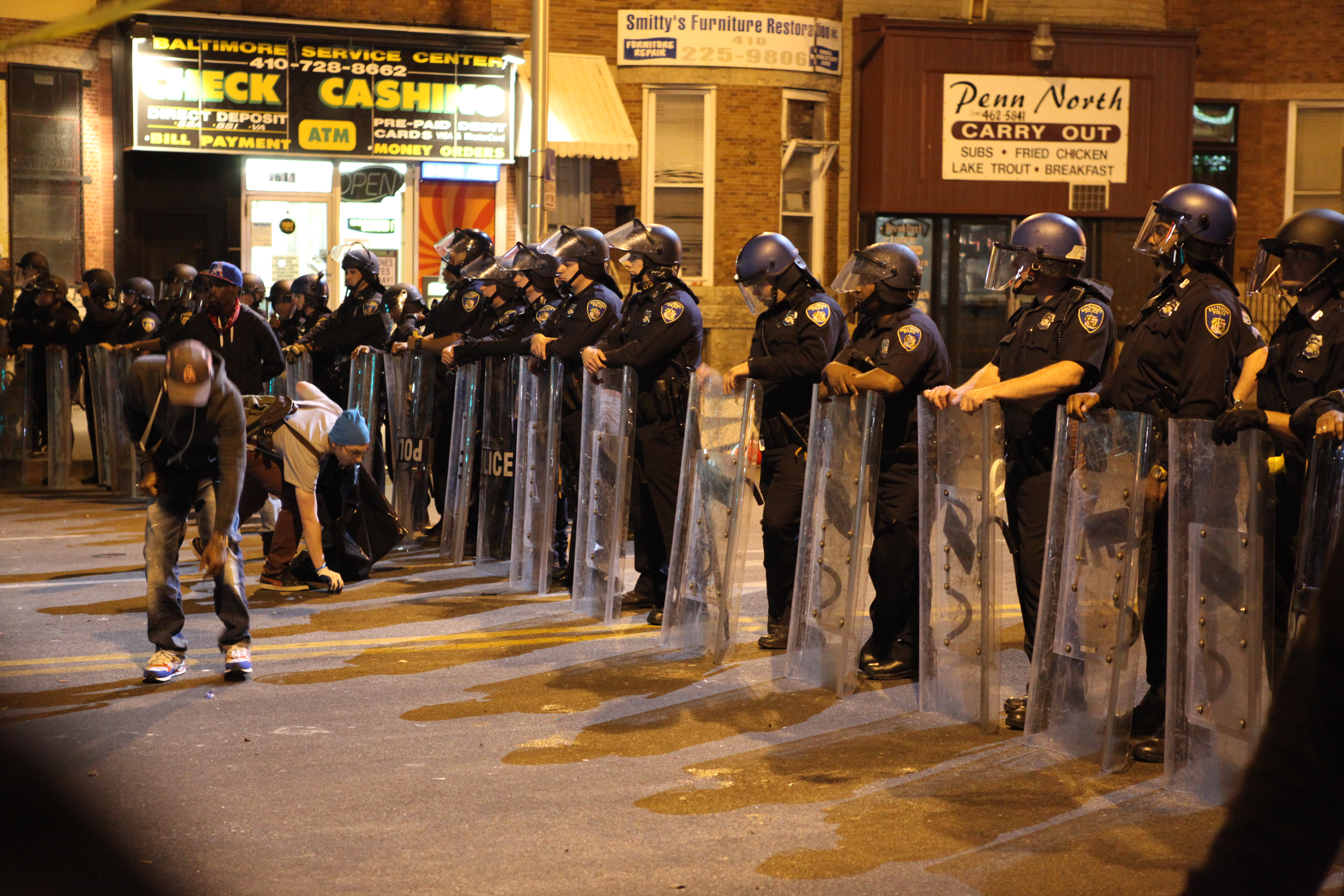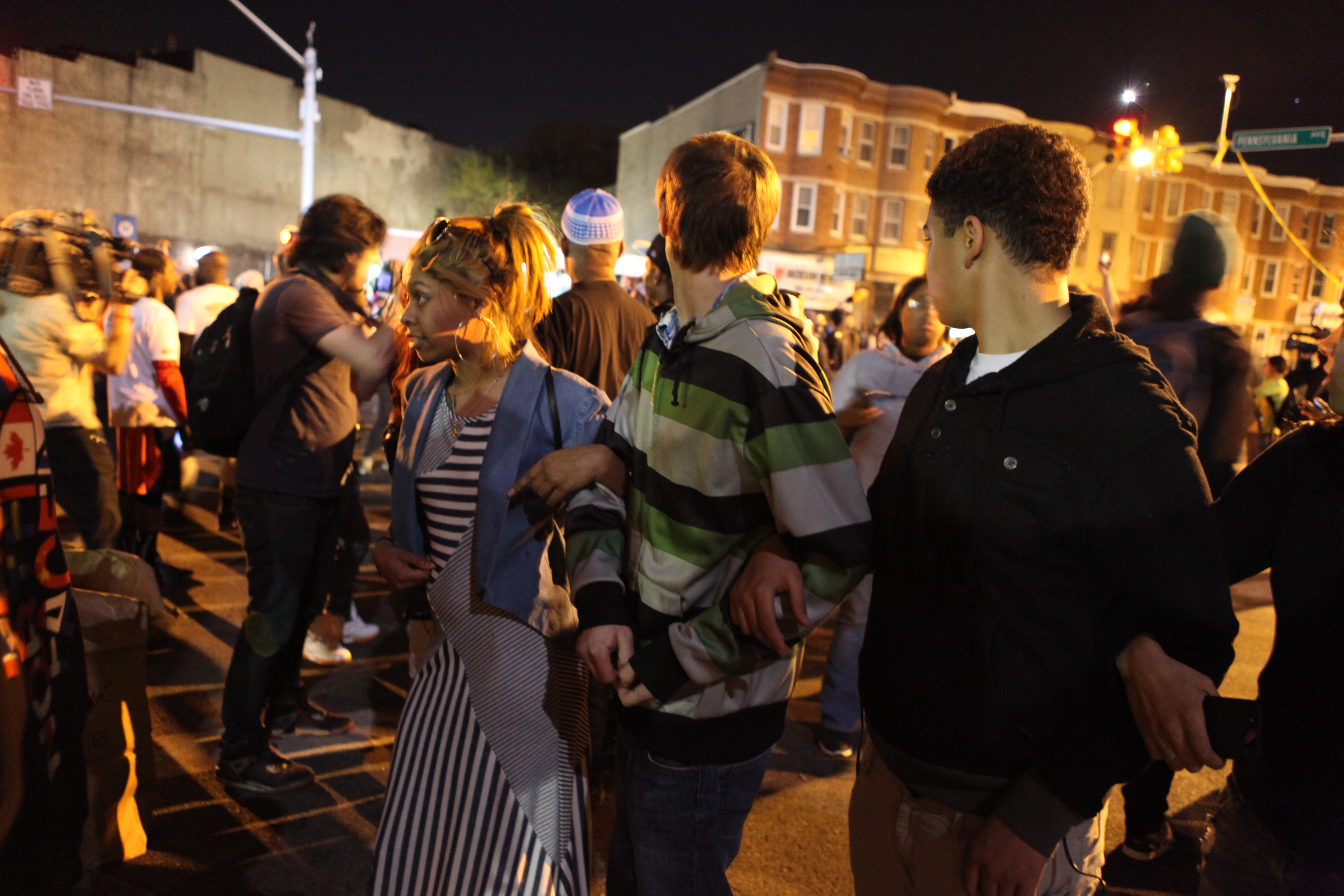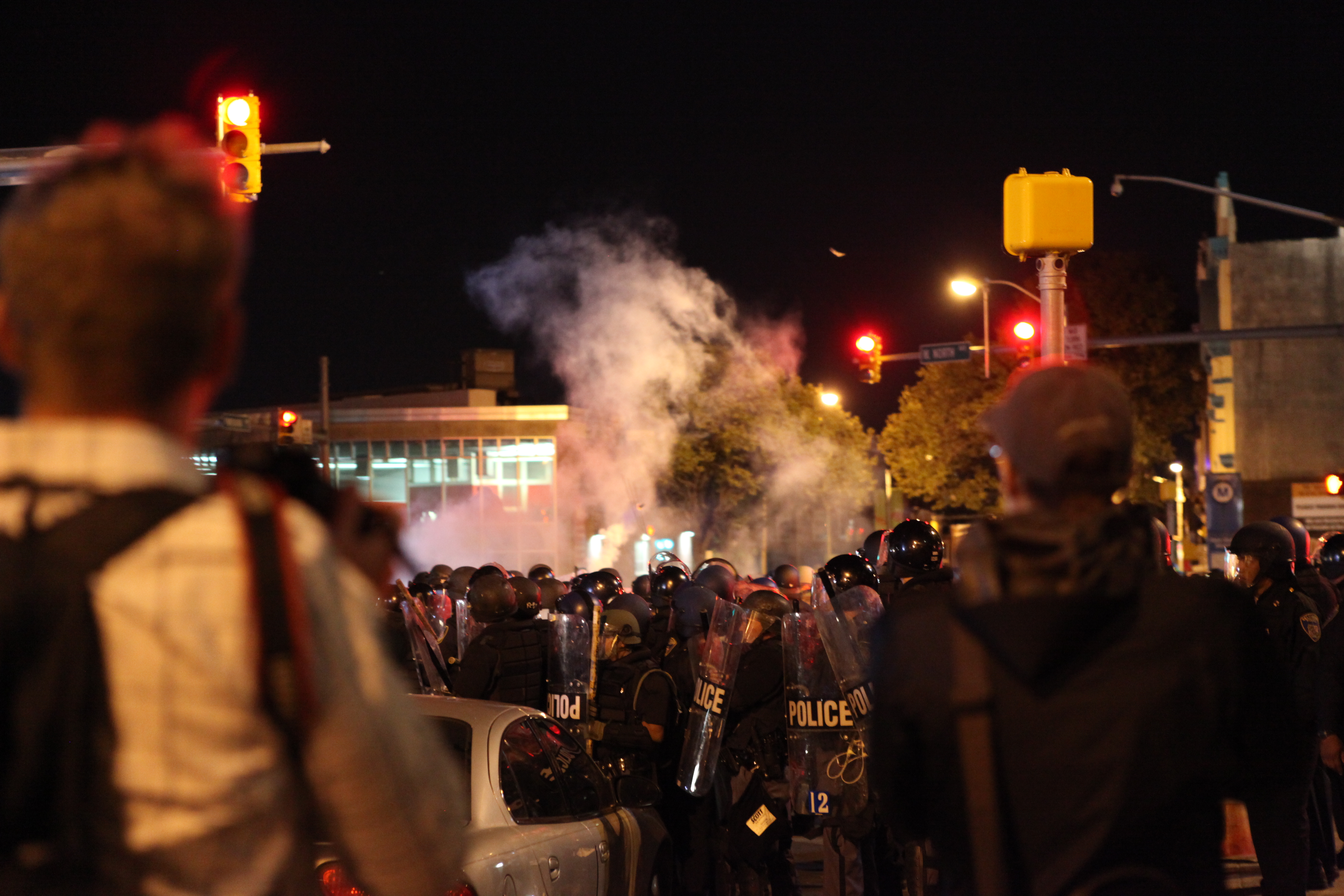Medill National Security Reporting Project
 Medill/GlobalPost investigation sheds new light on $3.2 billion U.S. mine clearance and victim assistance effort.
Medill/GlobalPost investigation sheds new light on $3.2 billion U.S. mine clearance and victim assistance effort.
→ Visit the project site
→ Read more about the project
 Medill/USA TODAY investigation of U.S. international food aid programs finds significant, entrenched problems
Read about the project.
Medill/USA TODAY investigation of U.S. international food aid programs finds significant, entrenched problems
Read about the project.Like and follow us
R.I.P. James Wright Foley, 1973-2014
#MedillRemembers James Foley, One Year Later
Remembering James Foley's life and legacy one year after his death at the hands of the Islamic State. → Continue to the story.
→ Continue to the story.
→ James Foley: A legacy that lives on (VIDEO)
Major TV networks sign onto freelancer safety compact
Read about the compact, which was signed by Medill NSJI Co-Director Ellen Shearer at Columbia University in September, here.-
Real-time Twitter feed
NSJI in the News
The Voice of America featured NSJI in a recent article about how it prepares journalists to cover stories in conflict zones.McCormick Foundation renews grant for Medill National Security Journalism program
EVANSTON, Ill. — The Robert R. McCormick Foundation has renewed a $1 million grant to fund the Medill National Security Journalism Initiative at Northwestern University over the next two years.

The NSJ program provides journalists-in-training and working journalists with the knowledge and skills necessary to report accurately, completely and with context on events and issues related to defense, security and civil liberties. The initiative began in January, 2009 with an initial three-year, $1.3 million McCormick Foundation grant. The grant was also renewed for $1 million over two years in 2011.
About the initiative
By the Medill National Security Journalism Initiative, in partnership with the McCormick Foundation.Links we recommend
- Campaign for Innocent Victims in Conflict
- Global Warning
- International Reporting Project
- McCormick Foundation
- Medill
- Medill Washington
- Military Reporters & Editors
- Northwestern University
- Security Clearance
- The Center for Public Integrity
- The Crimes of War Projct
- The Dart Center
- Washington Post National Security news
Tag Archives: journalism
#MedillRemembers James Foley, One Year Later
The Debrief: Guantanamo Edition // OPSEC 101
In the third installment of “The Debrief: Guantanamo Edition,” Medill NSJI reporters Taylor Hall and Ezra Kaplan give you a crash course in OPSEC, or operations security, as it pertains to reporting from Naval Station Guantanamo Bay. Learn what OPSEC and how to navigate it in the course of your Guantanamo coverage.
Considering religious motivations to counter Islamic State
WASHINGTON — Religious experts are saying the U.S. approach with ISIS should be more focused on the movement’s ideology. Islamic extremists claim to be restoring the faith to its original interpretation as part of their recruitment strategy. Experts say interpretations of religion are meant to evolve over time.
“What if a message like the Koran was revealed in modern society, let’s say New York City,” Brookings fellow Shadi Hamid said. “So for example, when it comes to gay rights, presumably anything revealed today in New York would have a little bit of a different perspective, a more tolerant one. They’d say, ‘this doesn’t really relate to our modern context.”
The sentimental appeal ISIS is using continues to give the group momentum, with the ultimate goal being to take over and reform the Caliphate.
Medill NSJI, MRE and SPJ send letter to Army Secretary
WASHINGTON — Military Reporters and Editors, the Society of Professional Journalists and Northwestern University’s National Security Journalism Initiative sent a joint letter to Army Secretary John McHugh on June 19, requesting the immediate declassification of the investigation into Staff Sgt. Robert Bales’ horrific crimes in Afghanistan in March 2012.
Bales was sentenced to life in prison in August 2013 for murdering 16 Afghan civilians, including many women and children, during two solo nighttime raids in small villages in Kandahar province. The gruesome murders—dubbed the Kandahar massacre—sparked angry protests and forced the U.S. military to temporarily halt combat operations in the region.
“Bales pleaded guilty to his crimes and will spend the rest of his life in prison. His clemency request has been denied and U.S. forces are no longer operating at the combat outposts where he committed his crimes. We see no reason why the investigation should remain classified,” said MRE President Amy McCullough. “The reasons U.S. Central Command gave to some of our members for denying repeated FOIA requests no longer apply, and the public has a right to know if there was anything that could have been done to prevent this tragedy. I sincerely hope Secretary McHugh will do the right thing and declassify this report before his tenure ends.”
“The Pentagon has examined the events leading to Staff Sgt. Robert Bales’ crimes in Kandahar province, but the public has only the military’s word that it has done everything possible to learn from the incidents,” said Ellen Shearer, co-director of Northwestern University’s National Security Journalism Initiative. “The continued lack of transparency in this case is a shameful example of denying the public its right to know the truth about an important, terrible event in the war in Afghanistan.”
The letter reads, as follows:
June 19, 2015
Dear Secretary McHugh,
We write to draw your attention to an important document regarding SSgt. Robert Bales’ crimes in Kandahar province that has been concealed despite his conviction and the historic significance of the atrocities he committed. These obstacles are troubling to Military Reporters and Editors, the Society of Professional Journalists, and Northwestern University’s National Security Journalism Initiative. The gravity of Bales’ crimes argues for transparency in all aspects of his case. We ask you for your assistance in declassifying an Army regulation 15-6 investigation into Bales’ killings before your tenure as Army Secretary ends.
Since Bales’ was sentenced to life in prison in August 2013, three news organizations from the Puget Sound region near JB Lewis-McChord have submitted multiple Freedom of Information Act requests for an Army Regulation 15-6 investigation commissioned to look into whether anything could have been done to prevent Bales’ massacre in March 2012.
The News Tribune of Tacoma, The Seattle Times and NPR Seattle affiliate KUOW have had their FOIA requests denied and their appeals delayed. Normally, investigative documents used during courts-martial may be released through FOIA following the resolution of a case. That has not happened with the Bales 15-6.
U.S. Central Command rejected The News Tribune’s first request for the Bales 15-6 in January 2014. The reasons listed by Central Command included:
- JBLM’s I Corps headquarters had not yet considered Bales’ clemency
- Releasing the 15-6 could jeopardize ongoing operations for frequently deployed
- Releasing the 15-6 could obstruct a law enforcement
- Releasing the 15-6 could impair Bales’ rights to a fair and impartial
The News Tribune filed an appeal to this denial. CENTCOM has not yet considered it. CENTCOM has confirmed that The News Tribune’s appeal is No. 235 in line for further consideration, but has repeated the reasoning it offered to The News Tribune in denying FOIA requests from The Seattle Times and KUOW.
In the 17 months that have passed since CENTCOM’s denial, facts have changed that warrant an immediate reconsideration of CENTCOM’s withholding of the Bales 15-6.
- I Corps Commander Lt. Gen. Stephen Lanza has denied Bales’ clemency request and upheld his sentence.
- S. forces are no longer stationed at combat outposts near where Bales committed his massacre, according to open-source news reports published by the Army. Moreover, testimony at Bales’ court-martial revealed how he twice walked out of his outpost to kill civilians. Releasing more information about that aspect of this incident could do no more harm to U.S. forces than has already been done.
- Bales has been convicted and sentenced to life in prison. There is no pending law enforcement investigation that could be influenced by the release of the 15-6.
- The FOIA exemption that protects a defendant’s right to a fair and impartial hearing is intended to ensure that military juries are unbiased. Bales is past the point when a jury may consider evidence in his case. His fate now rests solely with military appeals
Marine Corps Gen. John Allen commissioned the report just after the massacre. He discussed it in press interviews from Kabul, assuring the public the military would do everything it could to learn from Bales’ killings.
“I will be satisfied when I get the report that we have looked closely at the potential contributing factors that might have permitted this event to have unfolded tragically,” Allen told reporters in March 2012, two weeks after the killings.
Bales committed a terrible crime and is serving his sentence. The public and the press still deserve the answers to the questions Allen aired when he announced the 15-6.
Sincerely,
Amy McCullough, MRE President
News Editor, Air Force MagazineIsaac Cubillos, MRE Vice President
Editor, Military Media GroupOtto Kreisher, MRE Treasurer
Freelance ReporterBryan Bender, MRE Board member
Defense Editor, PoliticoKristina Wong, MRE Board member
Defense Reporter, The HillDan Lamothe, MRE Board member
National Security Reporter, The Washington PostAlex Quade, MRE Board member
Freelance War ReporterGreg Mathieson, MRE Board member
Combat PhotographerJenn Rowell, MRE Board member
Military Reporter, Great Falls (Mont.) TribuneJohn Grady, MRE Board member
Freelance National Security ReporterEllen Shearer, Co-Director National Security Journalism Initiative
Professor, Northwestern University’s Medill School of JournalismDana Neuts, SPJ President
Freelance JournalistPaul Fletcher, SPJ President-Elect
Publisher/Editor-in-Chief, Virginia Lawyers WeeklyKaren Peterson, Executive Editor
The News TribuneKathy Best, Editor
The Seattle TimesPatricia Murphy, Military/Veterans Reporter
KUOW
Tagged Army Secretary, Army Secretary McHugh, journalism, Medill National Security Journalism Initiative, Medill NSJI, Military Reporters & Editors, MRE, open records, reporting, Robert Bales, Robert Bales Afghanistan, Secretary of the Army, Society of Professional Journalists, SPJ, Staff Sergeant Robert Bales, Staff Sgt. Robert Bales, transparency
Fourteen fallen journalists immortalized at Newseum
WASHINGTON—The Newseum honored 14 journalists on June 8 for their courage while reporting under hostile conditions, representing all journalists who died in 2014.
Family members and friends of the fallen attended the museum’s annual Journalists Memorial, which recognizes the risks journalists face in getting the news.
“It has been a brutal time for journalists worldwide. Numbers vary, but according to most international media organizations, more than 80 journalists were killed last year,” said Kathy Gannon, an award-winning Associated Press correspondent who was shot at by an Afghan police officer in April of last year while in a car. Her colleague Anja Niedringhaus died in the attack.
Gannon was the recent recipient of the 2014 James Foley Medal for Courage in Journalism awarded by Northwestern University’s Medill School of Journalism.
After her speech Gannon hugged friends, some were teary-eyed.
John Foley, father of the late James Foley, honored his son and all journalists killed last year.
In his last letter addressed to his family in captivity, James wrote: “I know you are thinking of me and praying for me. And I am so thankful. I feel you all especially when I pray. I pray for you to stay strong and to believe. I really feel I can touch you even in this darkness when I pray.”
Islamic State militants beheaded him in August.
“He left his mark as a wonderful human being,” Foley said. “He defended our right to know.”
Islamic State militants also murdered journalist Steven Sotloff in 2014.
While crossing into Syria from Turkey, Sotloff was abducted by the Islamic State in 2013. He was killed in September, the execution videotaped and released online.
Sotloff’s mother Shirley, accompanied by her husband Arthur, read her son’s handwritten words aloud. The words were also written while Sotloff was taken hostage: “Everyone has two lives. The second one begins when you realize you only have one.”
The 2Lives foundation was created in honor of Sotloff to “support aspiring young journalists,” according to his mother.
Shirley said Sotloff’s dedication to the Newseum’s Journalists Memorial held a special place in the their hearts.
Peter Prichard, chairman and chief executive officer of the Newseum, said that attention should be placed on why the journalists passed instead of how they passed.
“It’s certainly right and just that we pause today in our busy lives to remember what these journalists did and why they did it,” Prichard said. “And it’s also right that we should recognize and honor the family members who have lost their loved ones for what is, in the end, a noble cause.”
A hashtag –#WithoutNews –accompanied Monday’s event, urging news consumers to think about the threats experienced by journalists as they report.
The hashtag also asked individuals to envision a world without news.
Tagged James Foley, Jim Foley, journalism, journalists, Medill, Medill National Security Journalism Initiative, Medill National Security Zone, Medill NSJI, Medill NSZ, Medill School, Medill School of Journalism, National Security Journalism Initiative, National Security Zone, Newseum, NSJI, NSZ, Ramsen Shamon, Ramsen Shamon Medill, reporter, reporters, reporting, Shamon Medill
Should the U.S. government negotiate with terrorists?
The safety of Americans abroad is a top priority for the U.S. government. Whether working in a U.S. embassy or on an aid mission, all American lives are valued. When these lives are taken hostage by terrorists, their rescue becomes extremely complex.
Chris Voss, CEO and founder of the Black Swan Group, said kidnappings of American hostages makes him angry.
![Chris Voss is the founder and CEO of the Black Swan Group. “There are few people that have worked for the [U.S.] government that know as much about international kidnapping as I do,” he said. (Photo courtesy of the Black Swan Group)](../../../wp-content/uploads/2015/06/ChrisVoss-blueshirt-small.jpg)
Chris Voss is the founder and CEO of the Black Swan Group. “There are few people that have worked for the [U.S.] government that know as much about international kidnapping as I do,” he said. (Photo courtesy of the Black Swan Group)
The Black Swan Group prepares its clients to handle the unpredictable. Voss has 24 years of FBI experience and was their lead international kidnapping negotiator.
He said that he has been involved with about 150 successful rescuing cases worldwide, some involving children, in countries like Haiti, Iraq, Afghanistan, Saudi Arabia and Pakistan.
In 2011, al-Qaida militants in Pakistan kidnapped an American named Warren Weinstein. He was accidently killed by a U.S. drone in January.
During his captivity the White House said it would not negotiate with terrorists for his release.
Elaine Weinstein released a statement after learning about her husband’s fatality: “We hope that my husband’s death and the others who have faced similar tragedies in recent months will finally prompt the U.S. government to take its responsibilities seriously and establish a coordinated and consistent approach to supporting hostages and their families.”
A bipartisan amendment to the 2016 National Defense Authorization Act, headed by Democratic Rep. John Delaney of Maryland and California Rep. Duncan Hunter, a Republican, called for the creation of a “hostage czar.” Weinstein was Rep. Delaney’s constituent.
The legislation, approved by the House of Representatives, includes an Interagency Hostage Recovery Coordinator. Some of the coordinator’s tasks would include engaging in rescue missions alongside all levels of the federal government and keeping families up-to-date with hostage-related developments.
The amendment, however, does not permit negotiations with terrorists.
Voss said he has not negotiated with terrorists in his career, but rather has been involved with “third-party intermediaries” or “proxies.”
Journalists like James Foley and Steve Sotloff, who were kidnapped and then killed by Islamic State militants, led many to question whether government bodies should negotiate with terrorists to secure the release of hostages.
If government agencies were to interact with terror groups, would their arrangements be honored? Would the terrorists demand more? Would everyday people be encouraged to kidnap Americans, knowing they could engage in extortion?
According to the U.S. Department of the Treasury, about $165 million has been paid to terror organizations in the form of ransom money, primarily funded by European governments.
The U.S. government has secretly negotiated with terrorists, but not through publicized monetary means. Army Sgt. Bowe Bergdahl, who was kidnapped for five years by Taliban sympathizers in Afghanistan, was swapped for five Guantanamo Bay detainees.
Trading prisoners of war is not unique to the United States. In 2006, Israel Defense Forces solider Gilad Shalit, held captive by the Palestinian terrorist group Hamas for five years, was exchanged for 1,027 Palestinian prisoners.
Tagged aid worker, aid worker kidnappings, aid workers, Black Swan Group, ISIL, ISIS, Islamic State, Islamic State of Iraq and Levant, Islamic State of Iraq and Syria, Islamic State of Iraq and the Levant, journalism, journalist kidnappings, journalists, Medill, Medill National Security Journalism Initiative, Medill National Security Zone, Medill NSJI, Medill NSZ, Medill School, Medill School of Journalism, National Security Journalism Initiative, National Security Zone, NSJI, NSZ, Ramsen Shamon, Ramsen Shamon Medill, Shamon Medill, Terrorism, terrorists
ISIS’ media plan: Kill one, win one thousand
Journalists are on the front lines covering terrorism. We are unarmed and unprotected. We work mostly alone. We not only work in hostile areas but now we are also the targets of terrorism.
It wasn’t always this way. Richard Engel, chief foreign correspondent for NBC News, noted at a panel discussion on reporting from the frontline at the University of Chicago in May that journalists used to enjoy some protection in hostile environments.
“The rebel groups didn’t like you,” said Engel. “But back then they knew they needed me because I was there to do a story about them and what I said had some sort of impact.”
But the code of conduct has changed. A reporter no longer serves as the messenger. Terrorists can cut out the journalist and go directly to the Internet to deliver their message. Engel believes the change occured because terrorists find journalists frustrating to deal with since they often edited interviews, taking rebels’ words out of context.
We are all familiar with the fate of James Foley as Medill students. He was one of our own, part of our extended family by education and trade. He was abducted while covering the Syrian civil war by the Islamic State of Iraq and Syria (ISIS) in 2012 and very publicly beheaded in a video that went viral in 2014.
Certainly journalists who cover terrorism on the front line face risks. There is no doubt that an assignment could end up with the story being published about the writer’s death. Yet, journalists can’t allow fear to stop the stories. I’m not advocating anyone put their life in danger for death defeats a journalist’s purpose: To get the story out to others who have the power and resources to make change happen. But we must continue reporting, taking calculated risks, so the world can have a fair and unbiased report of what is truly happening, rather than accept the propaganda terrorists push out as the truth.
Some experts believe that targeting Western journalists as part of an ISIS terrorism campaign is a critical part of its marketing plan to instill fear in journalists and the public.
“Terrorism works in a similar fashion as good advertising and marketing work,” said Angi English, executive director of the Texas Governor’s Committee on People with Disabilities, a part of the state’s emergency management division.
English recently graduated from the Masters program at the Naval Postgraduate School and Homeland Security where she studied national security issues. She recently wrote “The Social Influence of the ISIS Beheadings.”
Ken Aucremanne agrees. He formerly worked with the military and is a graduate researcher in social media at American University in Washington D.C. He said killing journalists is ISIS’ way of controlling its message. English adds that beheading journalists and putting the videos on social media can instill fear into the thousands of Americans that ISIS can’t reach directly because it gives them the message that their government can’t protect them.
“Kill one, win a thousand,” said English. “It’s a Chinese proverb. If it is so horrific that it jars our consciousness, our whole psyche, when you do it to one person, people get the message.”
ISIS is both symbolically and physically cutting off information to the West by cutting off journalists’ heads.
ISIS also has gotten extremely sophisticated in the way it uses video and social media. Terrorist groups used to put out shaky, grainy video but no more. ISIS has stolen video techniques from independent filmmakers and the journalists they kill.
“Terrorist organizations, for the most part, they don’t have critical infrastructure and resources to attack other nations,” said English.
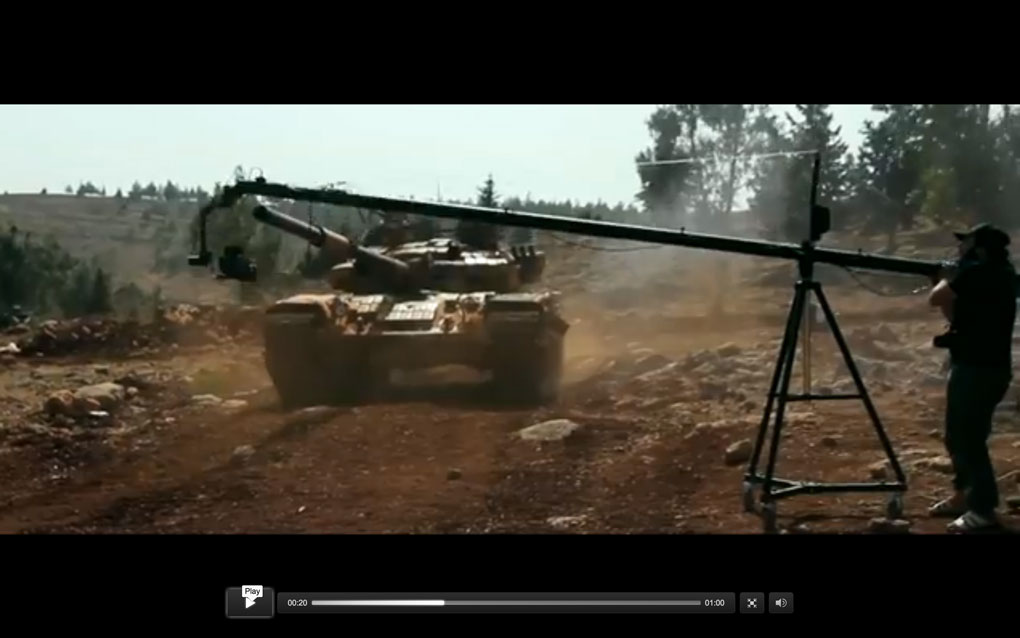
Screenshot of ISIS video on how it produces video.
Instead, they use video and social media as their tools of terror. ISIS creates and shares cinematic videos that people are drawn to, giving the terrorist group an air of credibility.
“Ten or 15 years ago if you wanted to get the whole world to see your vision, you had to send someone to flight school and target the World Trade Center, but today all you need to do is go to film school,” said Aucremanne.
Aucremanne believes ISIS is using video because cameras and equipment are inexpensive and unrestricted in ways that weapons are not. The second video in this Daily Mail article shows ISIS’ behind the scenes video production techniques. Jon Lee Anderson, a correspondent for the New Yorker, said during the frontline reporting panel at the University of Chicago rebels now need fewer tools to be terrorists.
“All that is needed to be a terrorist or commit global terrorism is an iPhone, knife and a victim, with that you have your battlefield,” he said. “You have tens of millions of people who are going to see that and be terrorized by it.”
The West focuses on the gruesome and graphic beheading videos, but those are only a small portion of the videos ISIS is releasing. Aucremanne said there are plenty of other videos designed to show ISIS fighters as heroes and instill Pan-Arabic pride that are being distributed through private social media channels.
Tagged frontline reporting, IOPFrontline, ISIL, ISIL video, ISIL videos, ISIS video, ISIS videos, Islamic State, Islamic State of Iraq and Levant, Islamic State of Iraq and Syria, Islamic State of Iraq and the Levant, Islamic State video, Islamic State videos, James Foley, Jon Lee Anderson, journalism, journalist safety, journalists, Kunshek, Medill, Medill National Security Journalism Initiative, Medill National Security Zone, Medill NSJI, Medill NSZ, Medill School, Medill School of Journalism, national security, National Security Journalism Initiative, National Security Zone, Niccole Kunshek, NSJI, NSZ, Richard Engel, Terrorism, UChicago Institute of Politics, UChicago IOP, UChicagoIOP, University of Chicago Institute of Politics
Guard operations center advises troops in Baltimore

BALTIMORE — As the third night of Baltimore’s curfew set in on Thursday, the Maryland National Guard stood watch over an empty City Hall. Their real action, however, took place 31 miles away at the Joint Operations Command in Adelphi, Maryland.
There, Joint Task Force Maryland had gone online to guide all National Guard operations in the state.
At 11:00 a.m. on Tuesday, the makeshift operations center was activated in a converted gymnasium at the Maryland National Guard Center to coordinate the approximately 2,000 soldiers streaming into the city from across Maryland, explained Capt. Patrick Elliot, who oversees day operations at the JOC.
In an interview Thursday evening, Elliot described JTF Maryland’s role in responding to the civil unrest in Baltimore.
“Anytime civilian assets are unable to address a problem, they call us in,” Elliot said. “Our job is to respond to and direct all Army assets in the state of Maryland.”
On Monday evening, the Maryland National Guard received Gov. Larry Hogan’s call to assist city and state police in responding to the violent protests that engulfed Baltimore after the death of Freddie Gray.
“We rehearse this every year, if not every couple months, on top of all the other Army [training] requirements” Elliott said. “I think it shows in the quick response that we were able to put on the ground to support the governor.”
The JOC, staffed by the 58th Troop Command, receives missions from the Maryland State Police through liaison officers to provide resources the police lack, logistical or transportation support and requests for extra forces to bolster security throughout Baltimore.
“In this type of sustained operations, there’s a lot that happens behind the scenes in order to support the troops that are out there,” Elliot said.
The mission has thus far proved successful, according to Elliot. The JOC has been able to provide continuous guidance on how to respond to conflict, how and when to use force, and what are appropriate escalation and de-escalation tactics.
“As a troop on the ground, it’s good to know that at the end of the day, you’re helping to protect the community,” Elliot said.
“The soldiers know that they’re protecting lives and property in Baltimore.”
Tagged Baltimore, Baltimore City Police Department, Baltimore PD, Baltimore police, Baltimore police department, Baltimore riots, demonstration, demonstrations, Freddie Gray, Freddy Gray, how to cover Baltimore, how to report in Baltimore, journalism, journalism resources, journalist, journalists, law enforcement, Maryland Army National Guard, Maryland National Guard, Medill National Security Journalism Initiative, Medill National Security Zone, Medill NSJI, Medill NSZ, Medill School, Medill School of Journalism, military, National Guard, national security, National Security Journalism Initiative, national security reporting, national security reporting resources, National Security Zone, NSJI, NSZ, police accountability, police brutality, protest, protests, reporter, reporters, reporting, reporting resources, riot, riots, state troopers, tips for journalists, tips for reporters, unrest
Advice from journalists covering the Freddie Gray fallout in Baltimore
Reporters, photographers and other journalists rarely receive formal training on how to cover urban protests and demonstrations. Usually they rely on the collected wisdom of colleagues who have had earlier experiences, some as recent as last year’s tension and violence in Ferguson, Missouri.
Now with the current demonstrations and violent protests in Baltimore following the death in police custody of 25-year-old Freddie Gray, another collection of journalists, young and old, is witnessing and learning what it means to cover unrest in one of the nation’s larger cities.
The lessons can be hard, the anxiety high and the consequences fearsome, so I went cautiously into the fray of Baltimore neighborhoods Tuesday to get a feel for the situation awaiting journalists on the ground and to gather reporting advice from veteran journalists, along with cautionary tips from military and community leaders. I was joined by Medill reporters Matt Schehl, Beth Lawrence and Zachary Vasile, who were also covering the tensions.
Here are some thoughts based on our observations and interviews that will help navigate reporting on often-violent street protests that can be as confusing as they are dangerous.
1. Don’t go it alone.
While flaming police cars and flying bricks tend to be the exception rather than the rule when it comes to covering protests, the whole “safety in numbers” maxim still applies.
The ability to operate across a variety of media is all well and good, but when time is of the essence and deadline is nearing, picking a niche at which you can excel can make the difference between a good story and a great one.
If you are a print journalist, it helps to be paired with a photographer. If you work in video, it helps to have a sound person. Regardless of how you mix-and-match your group’s components, having two (or more) players on your reporting team will increase your level of safety, help you fact-check details observed on the ground and allow you to focus wholly on your work within a single reporting medium versus trying to be a one-man band.
It’s also vital to set a rallying point before the start of an event – and especially a demonstration – where your reporting team can meet if anything goes awry. That way, even if your phone chargers die and you get separated in a large crowd, you can use that landmark as a point of reference for the sake of safety.
“Have a buddy and know where you parked your car,” says Reuters News Agency video producer Zachary Goelman.
2. Realize that the media is not a welcomed guest by everyone in the Baltimore community.
Two negative schools of thought regarding the media are gaining traction there.
The first is that the media has no place at peaceful demonstrations because it is sensationalism-obsessed, and, so, citizens assume that we’ll be disappointed unless we have a riot to show for our attendance and, therefore, we tend to tell unbalanced stories.
The second is that the media’s mere presence at demonstrations exacerbates tensions between civilians and law enforcement and essentially eggs the latter on, so an absence of media would result in increased peace between cops and the community.
While both of these points are worth considering, they also put journalists at risk of bodily harm or other types of harassment. It’s important to realize that clear communication can help build the missing trust.
Introduce yourself and your organization. Be open to hearing out subjects’ perspectives and building a story around them vs. trying to illicit responses that fit within a predetermined angle. Above all, treat your story subjects with respect and courtesy, and treat each introduction and interview as a human – rather than a business – transaction.
3. Understand preexisting biases.
Recognize that racial tension is high and many people may be reluctant to speak with reporters of any color. In the eyes of many local citizens, the Freddie Gray case is as much about race as it is about law-enforcement accountability.
4. Bring (or rent) a car.
You cannot rely on just Baltimore’s public transit system, the geography of the Freddie Gray story is wide and its major flash points may change quickly. Hopping in a car is much more time-efficient on deadline. If you’re car-less or can’t afford a rental, Uber is the next best thing. Wait times on Tuesday tended to be in the 3-5 minute range, and we didn’t pay more than $10 to get anywhere.
5. Pack the right equipment.
On Tuesday evening, the police-press dynamic at the protest around the intersection of West North and Pennsylvania avenues in Baltimore became very hostile, very quickly. Tear gas and smoke both came into play, in addition to projectiles being tossed by protestors at cops.
I didn’t bring a helmet, but I did bring a painter’s respirator (~$30 at Home Depot) just in case. I thought I was being paranoid, but soon as smoke appeared at Tuesday night’s protest and then saw other journalists donning gas masks and respirators of their own, I was glad I did.
Jeff Abell, a journalist with Baltimore Fox affiliate WBFF TV, advises journalists to keep a safe, reasonable distance from tear gas when it is deployed because the wind can carry the chemical your way even if you aren’t the intended target.
“If you’re out of sight, you’re gonna be out of mind,” he says.
Goelman, the video producer from Reuters, suggested packing “a bicycle helmet if you have it, a respirator if you can find one, some sort of eye protection” and “clothes you don’t mind donating” in addition to your normal reporting equipment.
And on a tech note, bring backup power for your backup power. Portable power sources run from about $5 (~one full smartphone charge, but not necessarily as powerful after the first go round) to $40 (~3 full smartphone charges and a bit sturdier), and are necessary investments for anyone heading out to Baltimore.
Unless your news organization gives you a generator to bring with you, there are zero places to plug in on the street. While coffee shops can be good options under regular circumstances, nearly every single local business we came across was closing before sunset in order to ensure the safety of its employees in the midst of the demonstrations.
“I would pack as many chargers as you have as possible because you will go through all of them,” Abell says. “Be sure you have some power supply because it doesn’t matter, you know, how much you think you have — everybody’s been running out and trying to plug in wherever you can see a plug.”
Portable wi-fi is also a must, since the citywide curfew means that all businesses have to be shuttered by 10 p.m. and cellular signals have been markedly slow within Baltimore.
6. Don’t assume that rules automatically will apply to you.
The Baltimore Police Department tweeted out a clarification message for journalists about the citywide curfew that took effect Tuesday.
Credentialed members of the MEDIA are exempt from the emergency curfew. Please use caution in the area of police enforcement.
— Baltimore Police (@BaltimorePolice) April 29, 2015
According to the message, anyone with credentials was exempt from the curfew.
However, during Tuesday’s protest, police in helicopters above the crowd and surrounding buildings repeatedly instructed members of the media to disperse or else risk arrest. Additionally, the Baltimore mayor showed up to personally urge journalists and protestors, alike, to go home prior to the curfew.
These warnings, combined with the threat of arrest against journalists who remained after the 10 p.m. cutoff, suggests that the curfew’s implementation is dynamic in practice. For this reason, we’d suggest any journalists covering demonstrations with a police presence to exercise an abundance of caution.
7. If you’re traveling with a camera, don’t stick it in anyone’s face without permission.
This should go without saying, but increasing tensions have resulted in increasing assaults on journalists within city limits – including equipment theft and physical assault – so no interview is worth testing the limits of the community’s patience.
8. Show up early and leave late.
Reporting days in Baltimore go by fast, so getting local by late morning or early afternoon will give you more time to scope out interviews with locals, arrange meetings with community leaders and more.
On the flipside, leaving late – especially from protests – can give you a feel for the police-civilian dynamics at play in communities or just give you an opportunity to follow up with someone whose perspective piqued your interest during an event.
“I would treat this as a story that moves on its own rather than one you can move in,” says Reuters’s Goelman. “I would rely on the media and the press relations office of the law enforcement institutions. Follow them on Twitter.”
9. Talk to the people in uniform.
On Tuesday, the Maryland National Guard, Maryland state troopers and Baltimore city police were scattered throughout the city in an attempt to maintain order. The average cop was carrying a gun, zip ties, a nightstick and a Taser gun, while military members were fully suited up and armed. While the equipment may look forbidding, it’s important to understand how law enforcement communication systems work.
Individual police officers usually are discouraged from speaking to the press, but members of the media can direct press requests for everything from interviews to ride-alongs to the department’s Public Information Officer, or PIO. From there, the PIO can route your request down the proper parts of the bureaucratic pipeline, and no one risks getting fired for talking to you.
Maryland National Guard Staff Sergeant Michael Davis, a Public Affairs Officer (PAO), said soldiers are generally briefed on what they are and aren’t allowed to discuss, so any soldier should, theoretically, be approachable by the public. However, he said, the standard practice is first to make a request of a military division’s PAO, but there won’t necessarily be a PAO with every group of National Guard soldiers.
“Most soldiers know what to say, what not to say,” Davis explained. “We’re not gonna give specifics about our mission [or] put ourselves in harm.”
According to Maryland National Guard Sergeant Adam Safley, soldiers are trained to know where to direct journalists to get the information they need. “If we can’t give you the answer, we’ll help you find the person that can give you the answer,” Safley says.
10. Realize that there is life (and news) after protests.
Media briefings with the mayor and police, prayer vigils and civic-action meetings are just a handful of entry points journalists could cover to expand the Baltimore dialogue past protests. The current controversy began with an arrest, injury and loss of life, so examining the systems at play in these respective stages of the Freddie Gray story – as well as the long-term impact of his death on his neighborhood and the greater Baltimore area – is crucial to telling it responsibly.
Hear what Deacon Kevin Underdue Sr., a Baltimore preacher, has to say on the subject:
Tagged Baltimore, Baltimore City Police Department, Baltimore PD, Baltimore police, Baltimore police department, Baltimore riots, demonstration, demonstrations, Freddie Gray, Freddy Gray, how to cover Baltimore, how to report in Baltimore, Jennifer-Leigh Oprihory, journalism, journalism resources, journalist, journalists, law enforcement, Maryland Army National Guard, Maryland National Guard, Medill National Security Journalism Initiative, Medill National Security Zone, Medill NSJI, Medill NSZ, Medill School, Medill School of Journalism, military, National Guard, national security, National Security Journalism Initiative, national security reporting, national security reporting resources, National Security Zone, NSJI, NSZ, police accountability, police brutality, protest, protests, reporter, reporters, reporting, reporting resources, riot, riots, state troopers, tips for journalists, tips for reporters, unrest
Encryption Becomes a Part of Journalists’ Toolkit
TEXT AND PHOTOS BY J. ZACH HOLLO FOR THE GROUNDTRUTH PROJECT & REPRINTED WITH PERMISSION.
WASHINGTON — When whistleblower Edward Snowden used an email encryption program called PGP to contact documentary filmmaker Laura Poitras, only a tiny fraction of journalists used it. The precaution, designed to scramble messages so only the sender and receiver can read them, was essential for Snowden to leak the information.
The series of stories that followed shocked the world and radically altered the way people think about government surveillance and the Internet. Now, encryption is becoming a standard item of the journalism toolkit, a must-have for anyone hoping to report on sensitive issues that might upset institutions of power. It was also the subject of a workshop recently held at Northwestern’s Medill newsroom in Washington, DC, which walked about 15 journalists through the basic software installations involved in setting up PGP, which is short for “Pretty Good Privacy” and ironically named after a grocery store in Garrison Keillor’s fictional town of Lake Wobegon.
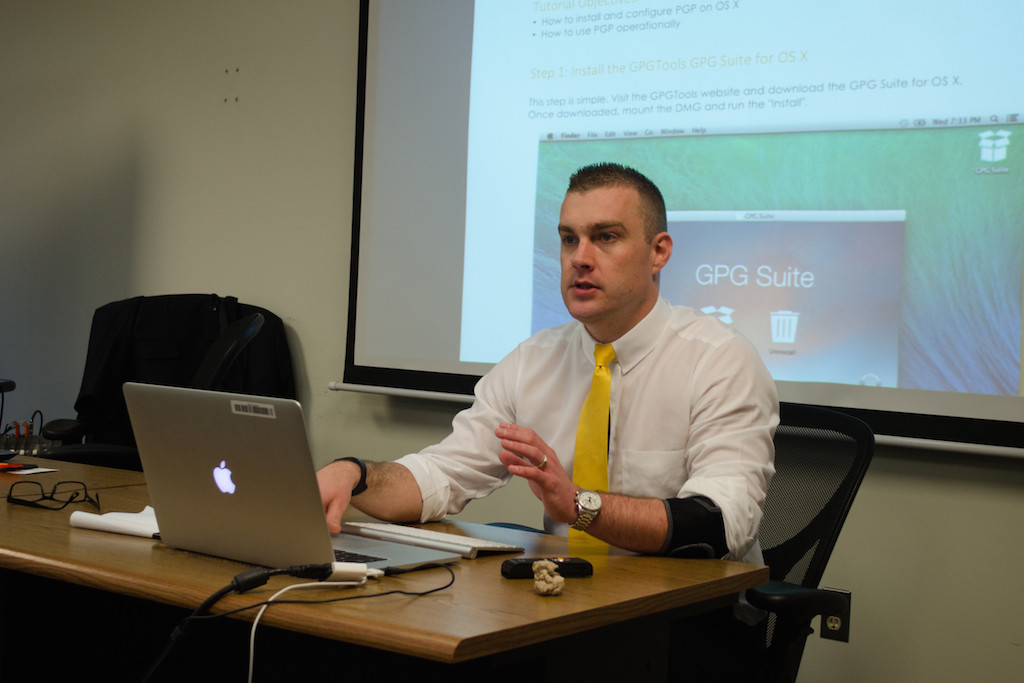
Aaron Rinehart displays the GPG encryption download suite for those at the workshop to follow along. (J. Zach Hollo/THE GROUNDTRUTH PROJECT)
For Aaron Rinehart, one of the workshop’s leaders, the goal is to protect the relationship between journalists and their sources, “to get journalists confident using these tools so sources feel they can give them information safely,” said Rinehart. Without that possibility, he said, the Fourth Estate could be fundamentally crippled.
And it’s not just the NSA journalists and sources need to protect themselves from, warned Rinehart. He used an example of a story exposing pharmaceutical malpractice. “It’s not that sexy of an issue, right? But just think of the potential adversaries.” There’s the government whose regulators screwed up, the drug companies who are poisoning people, and their stakeholders who don’t want to lose profits. With any story, there are likely a host of people who want to hack the journalist and sources to prevent the information from being aired.
The workshop was taught by Rinehart and digital security advisers David Reese and Ferdous Al-Faruque. Rinehart and Reese recently founded TestBed Inc., a technology consulting company. And Al-Faruque is a master’s journalism student at the University of Missouri who said he wants to establish a class there on encryption and cyber security.
Rinehart, who spent time in Djibouti while serving in the Marine Corps, said his motivation for putting on the workshop came from a time when journalism salvaged his college career. “The media saved me,” he said. About a decade ago, Rinehart faced a bureaucratic nightmare at the University of Missouri, when he returned from serving abroad and was not permitted to complete his studies. A local paper led an investigation into the problems veterans were having there, and the university changed policies. Since then, Rinehart said he tries to do all he can to help journalists.
Of the reporters who attended, many are intent on investigative work like the kind that exposed the NSA’s mass, indiscriminate surveillance. “Since I cover national security and defense, I would definitely use this to coax sources to communicate with me or send me documents that they don’t want their government or our government to see or know about,” said Kristina Wong, a reporter for The Hill.
But others also attended, including a cryptologist who said he comes to events like this out of professional interest, and a human rights worker.
“In a lot of countries, activists and human rights defenders especially are really targeted,” said Sarah Kinosian, who monitors American security assistance in Latin America for the Center for International Policy. “So we want to make sure [victims] can pass documentation to us in a safe way.”
The workshop began with Rinehart and Reese playing a segment of Citizen Four, Poitras’s documentary on Snowden and government surveillance that recently won an academy award.
“I would like to confirm out of email that the keys we exchanged were not intercepted and replaced by your surveillance,” a narrator said, reading Snowden’s correspondence with Poitras as a line of ominous tunnel light split darkness on the screen. “Please confirm that no one has ever had a copy of your private key and that it uses a strong passphrase.” Rinehart interjected: “That is what we will be teaching you today.”
He then spoke for a while on the importance of responsible password management, recommending a program called KeePass, before moving on to downloading email client software and installing extensions designed to encrypt communications.
The way it works can seem daunting and complex, especially for anyone not tech-savvy. The email extension, called GPG or PGP, generates both a public and private key for each user. When PGP is used to send an email, the sender uses the receiver’s public key to encrypt the contents of the email so only the receiver’s private key can decrypt it.
Also on the other end, the receiver can see that the sender’s identity is confirmed. A public key is just what it sounds like: something meant to be made public along with an email address so the owner can be contacted by anyone. The private key must be kept secret by the owner, and is used to decrypt messages sent using his or her public key.
In essence, it’s is the same concept of an email. Anyone can send a message to someone but only that someone can read it. But encryption makes it nearly impossible for that message to be intercepted. And while subpoenas can force Google or Yahoo to turn over peoples’ emails, PGP makes it impossible for Google and Yahoo to read the messages, so they’d be turning over incoherent nonsense (although it is still possible to see who the sender and receiver are, and the subject line of the email is not encrypted. Ergo, aliases are commonly used once initial contact is made).
Click here to see my public key.
Encryption’s complexity has deterred it from becoming widespread, even in newsrooms. “At The Hill, not many people use it at all,” said Wong, something many would deem troublesome given the publication’s focus on politics and aim to bring transparency to Washington.
But most people agree the complexity is in the technical details behind the process, not in its application. “The world of cryptology and algorithms and coding that goes into encryption tools is difficult for just about anyone to comprehend,” Rinehart said. “But using the tools is quite simple for people who take the time to learn.”
While the majority journalists still do not use encryption, it is becoming common practice for many organizations who do investigative work. The New Yorker, The Intercept, Washington Post, and ProPublica are a few of the early sign-ons for Secure Drop, a new encryption system for journalists designed by the Freedom of the Press Foundation and originally coded by Kevin Poulsen and the late Aaron Swartz. Gawker is another publication that uses it, showing encryption may become more widespread for groups focused on less hard-hitting subjects as well.
[Editor’s note: This piece originally appeared in The Huffington Post.]
Tagged Aaron Rinehart, Cybersecurity, David Reese, encryption, GPG, gpg encryption, Ground Truth Project, GroundTruth, GroundTruth Project, Hollo, Huffington Post, J. Hollo, J. Zach Hollo, journalism, journalists, Medill DC, Medill National Security Journalism Initiative, Medill NSJI, Medill Qatar, Medill School, Medill School of Journalism, Medill Washington, Medill-Q, Military Reporters & Editors Association, Military Reporters and Editors Association, MRE, National Security Journalism Initiative, NSJI, PGP, PGP encryption, TestBed, TestBed Inc., The GroundTruth Project, The Huffington Post, Zach Hollo

